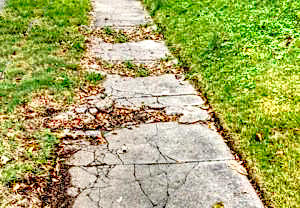Maintaining sidewalks and walkways  around your home is an integral part of the normal upkeep process. But just who is responsible for sidewalk maintenance? The homeowner or the city or county? This is a problem many homeowners ask about.
around your home is an integral part of the normal upkeep process. But just who is responsible for sidewalk maintenance? The homeowner or the city or county? This is a problem many homeowners ask about.
Individual states or local governments are responsible for setting the rules about who maintains the sidewalks in front of homes and buildings. Some may say that it is the homeowner’s responsibility, while in other states, it falls under governmental jurisdiction. In most states, however, sidewalk maintenance in front of your home is your—the homeowner’s—responsibility, or the responsibility of the homeowner’s association.
One reason to maintain your sidewalk and walkways is aesthetics. You want your property to look like it is taken care of. This will not only ensure its ongoing value, it will give you pleasure in enjoying it as well. If your walkways are filled with cracks, or sections are broken, crumbled or missing, it affects the curb appeal for your entire home and neighborhood.
Liability is the Biggest Reason for Sidewalk Maintenance
The biggest reason for sidewalk maintenance, however, is liability. As a homeowner, if someone trips and falls on your property, or slips on ice or a slippery surface, and is injured as a result of your negligence, you are liable. If a sidewalk is considered public property, the homeowner cannot be sued for physical injury sustained on the sidewalk. Cracks larger than one half inch, or lifts higher than three quarters of an inch, are considered tripping hazards.
What Causes Sidewalk Damage?
Very often it is nature itself wreaks the most damage on sidewalks and walkways, with variances in temperature, ice and snow, salt, earth settling, and tree roots the most common causes. Humans can also cause damage, often with shovels, lawnmowers and vehicles. Or sidewalks can simply deteriorate from age.
Depending on how severely your sidewalk is damaged, repairs can run from minimal to expensive. Replacing a section of sidewalk can cost into the thousands of dollars, while minor touch-ups for cracks or damaged areas can cost only a little.
If a sidewalk in front of your home is on public property, you can report the damage to your local municipality who will contract for repairs or instruct the homeowner that it is their responsibility to fix it. If the local jurisdiction contracts for a neighborhood repair in an older neighborhood where trees have caused damage, the cost for this repair may appear on homeowner tax bills.
In Fairfax County, Virginia, most sidewalks along public streets are maintained by the city or county. Those along private roads are the responsibility of the homeowner or association. For clearing of ice and snow, time limits and penalties are also enforced. For example, in Arlington County, VA residents and property owners are required to clear their walkways within 24-36 hours of a snowfall or incur a $100 penalty. In Loudoun County, snow and ice must be cleared within six hours of when the snow stops falling, or by noon the next day if the snowfall occurs overnight or incur a fine up to $250.
Först Consulting Group Provides Estate Management Services
Even when you are away from home, you are still responsible for maintaining your walkways, and should put into place contingency plans. Ask the neighbors to step in in exchange for helping them while they’re away.
For extended absences, Först Consulting Group offers an Estate Management service that looks in on your home while you’re away. We monitor your property inside and out, taking care of things like clearing snow and ice, replacing security lightbulbs and reporting any damage to the homeowner. We can even contract for repairs in your absence. If you are planning an extended trip, contact us.




